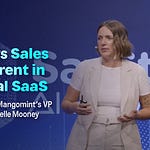Want to know when to move upmarket and how to actually pull it off?
Jeanne Dewitt Grosser (Chief Business Officer at Stripe) and Lindsey Scrase (COO at Checkr) have done it multiple times at companies like Google Cloud, Stripe, and Checkr. They came to SaaStr Annual to share what they’ve learned about making the move to go more enterprise actually work.
A Bit About Our Enterprise Leaders
Jeanne Dewitt Grosser
Currently Chief Business Officer at Stripe, running all technology and financial partnerships, plus corporate strategy
Scaled Stripe’s sales team from 10 to hundreds of reps across the Americas
Former leader at Dialpad (SaaS communications)
Built out Google Enterprise (now Google Cloud) SMB sales teams across APAC and Americas
Started at Google working on Gmail post-launch in operations
Known for analytical rigor and building teams from scratch
Lindsey Scrase
Current COO at Checkr (formerly CRO)
Runs bulk of Checkr’s operations after joining 2 years ago
Previously led Google Cloud for SMB, midmarket, and startups
Built and scaled multiple functions within Google Workplace
Started career at A.P. Moller-Maersk in global operating roles
Deep expertise in operational scaling and go-to-market strategy'
The 5 Key Things To Know About Moving Upmarket:
1. You Need Real Signals – Not Just Board Pressure
Most founders get the timing wrong on moving upmarket. Just because your board member wants a bigger TAM doesn’t mean you’re ready.
What you actually need:
Your existing customer base is literally pulling you upmarket. Think Shopify, Lyft, and Square bringing in grown-up CFOs and prepping for IPO – that’s what happened at Stripe.
You’re winning true enterprise workloads, not just “fins” (side projects or experimental business lines that don’t represent real adoption).
You have enough product maturity to actually serve enterprise needs – not just feature requests you can handle “soon.”
2. Going Enterprise Is a Company-Wide Decision
The #1 mistake? Thinking enterprise is just a go-to-market play. It’s not. You need:
A dedicated lighthouse engineering team building enterprise features
Solution architects and integration engineers (but be thoughtful about which roles you actually need)
Product and engineering in every major sales call
Aligned compensation across teams
Multi-year patience from leadership and board
As Lindsey puts it: “You can’t just dip your toe in enterprise. You have to go all in.”
3. The Enterprise Pricing Journey Is All About Unbundling
Stripe learned this the hard way. Their famous 2.9% + $0.30 pricing was brilliant for SMBs but completely wrong for enterprise. Why? Enterprise buyers:
Need predictability in pricing
Want to buy solutions, not features
Require modularity and customization
Have completely different procurement processes
The key is to repackage your components into enterprise-ready solutions. But watch out – this is a major undertaking that touches product, engineering, sales, and finance.
4. The Metrics That Matter Have Changed Dramatically
The “growth at all costs” era is dead. In 2019, top SaaS companies spent 50-55% of revenue on sales and marketing. In 2024? It’s down to 30%.
What you need to track obsessively:
Payback period (top quartile SaaS companies have 3x faster payback)
Gross margin
LTV:CAC by segment
Revenue ramp time
Win rates by industry
Break these down by segment and channel. Make them visible to everyone. Your teams need to act like owners.
5. Your Operating Model Must Be Bottom-Up
The most successful enterprise moves are built on granular operating models that show exactly what needs to be true to hit targets. You need:
Detailed funnel math (leads → opportunities → wins)
Conversion rates by stage
Average opportunity size assumptions
Revenue ramp time models
Cost breakdowns by function
Build this model by segment. Use it as a diagnostic tool. Update it constantly.
Real World Examples: How Stripe and Checkr Did It
Stripe’s Enterprise Evolution:
Started with signals from growing customers (Shopify, Lyft, Square)
Won Amazon in Singapore as first major enterprise logo
Rebuilt pricing from scratch for enterprise needs
Now sees enterprise customers buying 2+ products on average
Focused heavily on financial automation products (Billing, Tax) to drive up ACVs
Checkr’s Playbook:
Targeted specific verticals: staffing, retail, manufacturing, hospitality
Built dedicated enterprise capacity across SE, product, and engineering
Created two distinct product lines (initial screening, ongoing Trust product)
Actually paused their first enterprise push when they realized their product wasn’t ready
The 5 Signs You’re Actually Ready for Enterprise:
Your existing customers are growing into enterprise needs
You’re winning real workloads, not side projects
Your product can handle enterprise requirements today (not soon)
You can dedicate real engineering resources
Your board understands this is a multi-year journey
What To Do Next:
Build your bottom-up operating model now
Map out your lighthouse account list
Do the hard work of rethinking pricing and packaging
Get engineering and product bought in early
Set up the metrics dashboard your team needs
Remember: This is a multi-year journey. But if you get it right, the rewards are enormous. Just look at Stripe and Checkr’s trajectories.










